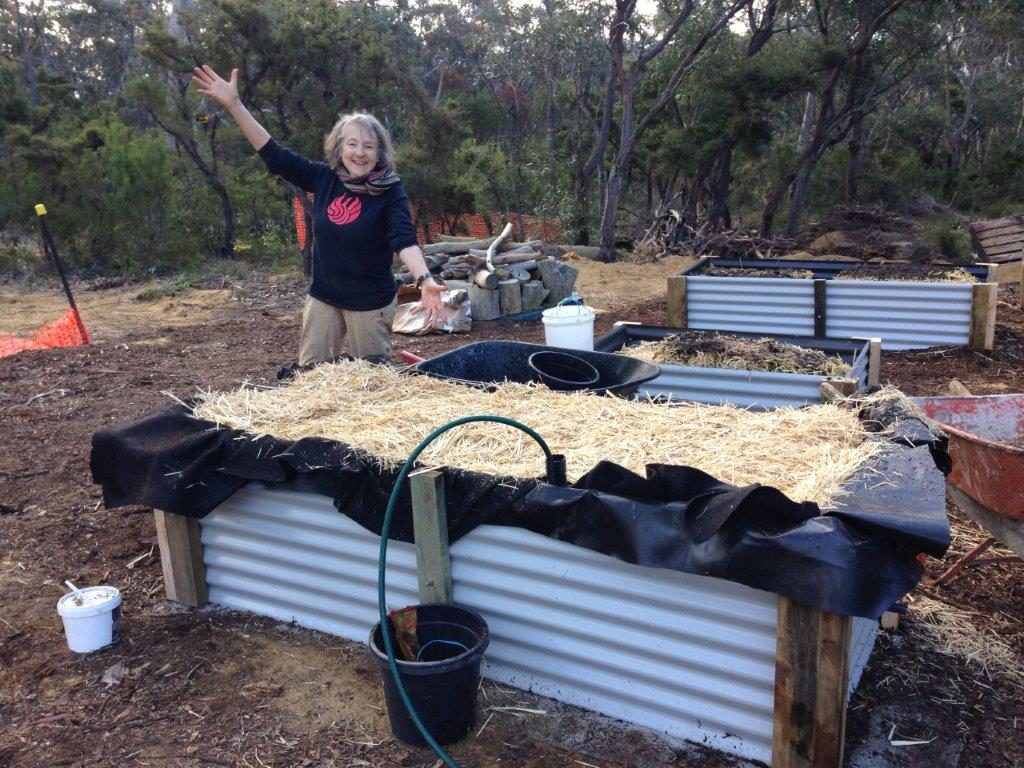Water restrictions at a time when your edible garden desperately needs watering might seem like a disaster, but can also be an opportunity to learn more efficient, eco-friendly skills. A lot of the things you do for yourself on hot days are applicable to plants – staying hydrated and covering up! Science writer, activist, and permie, Cat Dorey, has pulled together some of the things our SEGT hosts are doing to keep their gardens alive.
1. Keeping hydrated – start with the soil
Make sure you have a good volume of compost in your soil (30–50% depending on the soil quality). This improves soil structure, keeps microbes happy, and helps retain water.
After rain or watering, the top soil often looks wet, but just a few centimetres down it can be bone dry. Always look closer and consider getting a moisture meter – a probe you can stick into the soil to check water content.
If your soil has dried out completely it might become hydrophobic and have trouble rehydrating, especially with sandy soils and potted plants. The water sits on top of the soil instead of properly saturating it, or takes the path of least resistance, running down the inside wall of the pot and straight out the bottom. Submersing pots in a tub of water can really help! Soak them until the air bubbles are all gone, and drain in an empty tub to save that precious water.
You might need to add a soil hydrating agent to address hydrophobic soil, but be careful as many commercial ones are synthetic and not biodegradable. Gardening Australia’s Jerry Coleby-Williams has some great suggestions for organic wetting agents, including making your own from food-grade thickener, agar agar (algin), derived from seaweed. You can buy powdered kelp from a health food store. You might find that using a seaweed solution in your watering can more regularly when watering in summer is enough.
2. Cover up – mulch!
Always have a generous layer of mulch covering your soil. As well as suppressing weeds, mulch stops the soil drying out and can reduce watering by about 50%. Organic mulches like pea, sugarcane, or lucerne, break down slowly and add more organic matter to the soil. A layer of about 3-5cm is fine as you want water to get through. Be aware that some of the finely chopped mulches can create a thick mat that doesn’t let water through, especially after repeatedly drying out.
Leaves and grass mowings can be useful free mulches, but these tend to form mats. A mix of the two is better. Wood chips can work well under fruit trees. For any large, unplanted beds, cover them with cardboard or plastic sheeting to maintain moisture until you’re ready to plant, or plant some green manure as a living mulch to improve the soil.
3. Find or make some shade
On those really scorching days even the hardiest plants can struggle and suffer leaf burn. Build shade covers to protect them. A basic frame made from bamboo or plant stakes can be effective for holding up shade cloth. I’ve used old fly screens, safety netting from old trampolines, and even old sheets. For smaller plants try cardboard boxes, wicker baskets, or wire baskets covered in cloth.
Temporarily move potted plants to areas that get more shade. Remember that unglazed terracotta pots are permeable and, while they stay cooler, lose water faster than glazed pots. Pots can get very hot in the direct sun and bake the soil inside, so if you can’t move them, consider shading or wrapping them in hessian sacks or cardboard. My herb pots are grouped around two large concrete ‘pot ponds’ so those that need more shade can be protected by other larger pots.
In the longer term, think about how you plant your vegetable beds – taller hardier plants can provide shade for others. The cherry tomatoes that self-seeded behind my hardy fennel plants are doing very well compared to those elsewhere in my garden!
4. Build resistance and apply first aid
Make sure plants are getting nutrients regularly to keep them strong and healthy so they are more resistant to, and can recover from, water loss, heat stress, and sunburn. Use lots of good compost, worm castings, well-rotted manures, and seaweed emulsions.
Plants grown with seaweed emulsions are more tolerant to drought and revive quicker when treated with seaweed following heat stress – check out the evidence here.
5. Choose hardy plants
There are some edibles that just don’t cope in the heat, and as the changing climate means that Sydney weather will get hotter for longer, we all need to rethink what we can grow, where, and when.
I have one bed by the back door that is hard on plants because it gets full sun almost all day, plus reflected heat from the white wall. I’ve found that the drought tolerant Mediterranean herbs I once kept in pots are doing better there.
6. Clever ways to water
Hoses might seem like the quick and efficient way to water plants, especially when we’re limited to using a bucket or watering can, but there are better ways. Some plants don’t like being watered from above, and it can encourage fungal growth. Watering only the top of the soil can be fine for more shallow rooted plants, but much of the water can run off or evaporate. Why not use the water restrictions as motivation to try out some of these more efficient water-saving methods?
Watering spikes: a variety of manufacturers make a cone-shaped plastic spike or peg filled with sand or made from a permeable ceramic that lets the water leach out slowly and deeper into the soil. You could also make your own version from the many ideas online.

Ollas: (Oh-yahs) An ancient form of irrigation, these unglazed ceramic pots are buried in your garden with just the neck sticking out. They’re filled with water which leaches out slowly into the soil when it’s dry. You can even make them by sticking two terracotta pots together, mouth to mouth, with silicone glue and with one end plugged, or with one pot and a saucer on top.

Eco Bag Tree waterer: this 25 L permeable bag, from Green Harvest, sits around the truck of a tree slowly releasing water for up to a month. Great for young fruit trees as they get established!
Self-watering pots and beds: we could write a whole blog just on different ways to make these self-watering or ‘wicking’ devices. The basis of all wicking devices is that you have a water reservoir built within the pot or bed, below the soil and plants, which allows the water to move up through the soil by capillary action. Some designs have an overflow outlet to ensure that the plants don’t drown with too much water. Other designs have the pot or tub sitting above the water reservoir with a synthetic cords or fabric ‘wicks’ hanging from the pot into the reservoir that conducts water up into the soil.
You can buy a variety of pots that come with a water reservoir in the bottom and some manufacturers make a basic kit to convert your own pot. Just remember that it’s hard for soil to wick water up further than about 30 cm.
A wicking bed uses this idea on a larger scale within a raised vegetable bed. You can buy ready-made wicking beds, like the small Vegepods, or the modular system developed by our SEGT sponsors, Water-ups from Down-Under or custom-made beds from Very Edible Garden Wicking beds, or make your own. There are many resources online on how to build them.

Our garden hosts Nevin and Linda Sweeney have lots of ideas for making wicking beds and other wicking systems on their amazing website.
Finally, it’s a good time to get familiar with, or revisit, the 12 permaculture design principles. Every one of these principles, from ‘Observe and interact’ through to ‘Creatively use and respond to change’ are important right now! Learn from other gardeners by joining a local permaculture group or one of the many online groups, and really engage with your own garden to see what works and what doesn’t.
